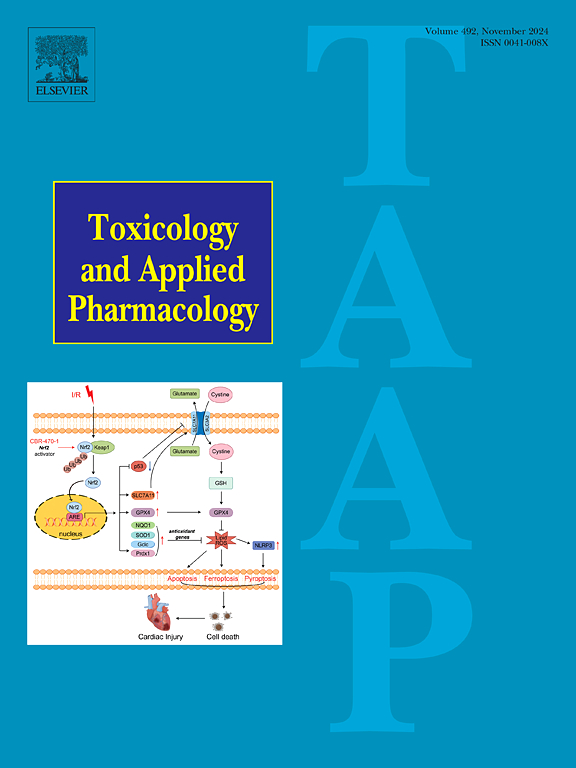Fudosteine attenuates lung inflammation in mice with PM2.5-induced asthma exacerbation by inhibiting pyroptosis via the NLRP3/caspase-1/GSDMD pathway
IF 3.3
3区 医学
Q2 PHARMACOLOGY & PHARMACY
引用次数: 0
Abstract
This study aimed to explore the potential preventive effects of fudosteine (Fud) on PM2.5-induced asthma exacerbations in a murine model. BALB/c mice were randomly allocated into six groups: control, Fud, ovalbumin (OVA), OVA+Fud, OVA+PM2.5, and OVA+PM2.5 + Fud. An asthma model was established through OVA sensitization and challenge. Compared to the OVA group, PM2.5 exposure exacerbated allergic asthma, as evidenced by increased collagen fiber deposition, goblet cell metaplasia, mucus secretion, heightened airway inflammation, elevated total cell and eosinophil counts, and upregulated levels of interleukin (IL)-1β, IL-18, and NLRP3 expression in lung tissues. Notably, fudosteine treatment mitigated these pathological changes. Western blot analysis revealed that fudosteine significantly reduced the expression of NLRP3, caspase-1, gasdermin D (GSDMD), cleaved-caspase-1, and cleaved-GSDMD in lung tissues. In conclusion, fudosteine alleviated lung inflammation, collagen deposition, and mucus secretion in PM2.5-induced asthma exacerbation, potentially by inhibiting the NLRP3 inflammasome-mediated pyroptosis pathway.
福多斯坦通过NLRP3/caspase-1/GSDMD途径抑制肺焦亡,减轻pm2.5诱导的哮喘加重小鼠的肺部炎症
本研究旨在探讨福多斯坦(fudostein, Fud)在小鼠模型中对pm2.5诱导的哮喘加重的潜在预防作用。BALB/c小鼠随机分为对照组、Fud组、卵清蛋白组、OVA+Fud组、OVA+PM2.5组和OVA+PM2.5 +Fud组。通过OVA致敏和激发建立哮喘模型。与OVA组相比,PM2.5暴露加重了过敏性哮喘,表现为胶原纤维沉积增加、杯状细胞化生、粘液分泌、气道炎症加剧、总细胞和嗜酸性粒细胞计数升高,以及肺组织中白细胞介素(IL)-1β、IL-18和NLRP3表达水平上调。值得注意的是,福多斯坦治疗减轻了这些病理改变。Western blot分析显示,福多斯坦显著降低NLRP3、caspase-1、gasdermin D (GSDMD)、cleaved-caspase-1、cleaved-GSDMD在肺组织中的表达。综上所述,福多斯坦可能通过抑制NLRP3炎症小体介导的焦亡途径,减轻了pm2.5诱导的哮喘加重中的肺部炎症、胶原沉积和粘液分泌。
本文章由计算机程序翻译,如有差异,请以英文原文为准。
求助全文
约1分钟内获得全文
求助全文
来源期刊
CiteScore
6.80
自引率
2.60%
发文量
309
审稿时长
32 days
期刊介绍:
Toxicology and Applied Pharmacology publishes original scientific research of relevance to animals or humans pertaining to the action of chemicals, drugs, or chemically-defined natural products.
Regular articles address mechanistic approaches to physiological, pharmacologic, biochemical, cellular, or molecular understanding of toxicologic/pathologic lesions and to methods used to describe these responses. Safety Science articles address outstanding state-of-the-art preclinical and human translational characterization of drug and chemical safety employing cutting-edge science. Highly significant Regulatory Safety Science articles will also be considered in this category. Papers concerned with alternatives to the use of experimental animals are encouraged.
Short articles report on high impact studies of broad interest to readers of TAAP that would benefit from rapid publication. These articles should contain no more than a combined total of four figures and tables. Authors should include in their cover letter the justification for consideration of their manuscript as a short article.

 求助内容:
求助内容: 应助结果提醒方式:
应助结果提醒方式:


